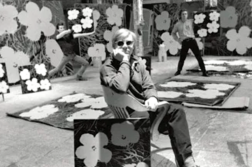ON THE AIR since 1990, HBO’s documentary series Real Sex has proven to be hugely popular with millions of cable subscribers curious about the sexual practices and fantasies of their fellow Americans. Ostensibly unscripted and nonfictional, the series’ ring of authenticity adds to its appeal. A viewer of Real Sex can expect to see something “different”—one segment spotlighted adults who pay to become human ponies at a special ranch—and in the bargain be titillated, offended, or amused. “Real Sex 25” was an episode that aired in 2000 and included a “strap-on party,” a “flirt fest,” an “erotic cabaret,” and a “pleasure party.” The strap-on party segment appeared first and followed the activities of the two women who organized and hosted the event.
In typical Real Sex fashion, the segment cuts back and forth between interviews and event footage. Attired in fetching, body-molding outfits, the women are seen putting up posters, shopping, and getting ready for the party. The interviews provide a context for and explain the main event. The assumption is that the viewer may be at a loss as to why the women gathered at the party are having such an obviously wonderful time brandishing, going down on, mock-masturbating, and even penetrating one another with strap-on dildos. Over the course of the segment, the two hostesses tell us about the use and significance of the strap-on: “There’s a whole generation of women who love their dicks, who have a collection of dicks, and party with their dicks.” The strap-on has revolutionary potential because “it gives everyone the power to fuck.” And, just in case viewers think that the only fun to be had is in confusing gender categories, they make it clear that the strap-on gives great physical pleasure: “The part of me that is meant to be penetrated feels good when it is.” This pleasure is by no means limited to the lucky woman on the receiving end: the strapped-on dildo stimulates the wearer’s clitoris as she thrusts. We are told that women can have multiple orgasms “just by doing the fuck.”
In just under fifteen minutes, anyone watching this segment is disabused of the notion that lesbian sex consists of kissing and cuddling, or that it’s restricted to manua1 and oral genital stimulation. The premium placed on cock and coitus by the heterosexual mainstream is implicitly upheld. The “strap-on party” is, after all, a segment that in word and image drives home the message that “lesbians love their sex toys.” However, this is cock and coitus with a difference. The hostesses show and tell us that dildo-based intercourse is not rooted in a fixed notion of gender or sexual identity but is rather an expression of play. One hostess informs us that “sometimes I want to be to a boy, sometimes I want to be a girl.” Her co-hostess declares, “I am as much a fucker as a fuckee.”
Leading us on a sexy, fun-filled tour of a sex-toy shop, their backstage dressing room, and the main event, the hostesses show the pleasure—and humor—to be had by challenging the categories of male and female, masculine and feminine. We see one of the hostesses, a lithe and lovely brunette, perform with her strap-on for an audience of cheering women. Wearing a bright red vinyl mini and clunky seven-inch heels, she “masturbates” her strap-on with a look of such fierce pleasure that her performance reads as an obvious parody of a male porn star in the throes of lust.
Through her performance, symbols of the ultra-feminine and the ur-masculine are brought together and exploded. Or are they? Is it really that simple to overthrow entrenched notions about gender and sex? Before we get swept away by the potent possibilities of millions of mainstream viewers having their understanding of human sexual practice and identity turned upside-down, it is important to consider the ways in which the radical possibilities of this message are mitigated or veiled.
Consider the ways in which the hostesses present themselves, represent lesbianism, and render palatable certain kinds of lesbian sexual practice for a largely heterosexual audience. The hostesses are femme lesbians who are obviously well-versed in the art of deploying their feminine wiles. They wear slinky dresses and skirts in pink, purple, red, and black. They strut around in high heels. They wear makeup. They not only look like “girls” but act like them, too. In a street shot of the hostesses putting up posters for the event, two young male passersby in business suits pause to see what’s going on and invite themselves to the party. In an apologetic tone of voice, one of the hostesses informs them that the party is for women only. Laughing, the men walk away, apparently mollified: a pretty lesbian who seems accustomed to “handling” men has just deftly defused a potentially hostile exchange.
On the street and in interviews, both women present a congenial face to the camera. One hostess tends to giggle when delivering bon mots about the pleasures of penetrating and being penetrated by other women. A perky redhead, she acknowledges that people tend to perceive her as being “innocent and sweet.” Her dark-haired co-hostess, the implied leader of the two, often uses “up-speak” when delivering her pronouncements on the ins and outs of lesbian sexual practice. “Upspeak”—the habit of ending a sentence or phrase with a higher pitch, as if it were a question—is a familiar characteristic of contemporary feminine speech. It can signify uncertainty, but it often expresses an interest in the listener (“Are you with me?”). Perhaps more importantly, upspeak signals that the speaker is neither threatening nor overbearing. It is a conciliatory rather than an aggressive mode of communication, and as such is typically associated with women and girls, most of whom are socialized from an early age to refrain from presenting themselves as aggressive.
To point out the hostesses’ overt feminine characteristics is not to shrug off the parodic aspect of their dress and behavior, nor to deny the potentially beneficial aspects of adopting such feminine tropes. One could certainly argue that their mode of presentation is strategic: they deliver beribboned bombs to the at-home viewer. Disarmed by their pretty looks and manners, the viewer may be more receptive to the ideas being presented than, say, if scowling butches were shown laying down the law about lesbian sex. Furthermore, there are certain moments when the hostesses become so over-the-top that they’re more like drag queens than lesbians. While trying on possible outfits for the party, one hostess informs the other of the sartorial advantage of a dildo she’s holding: “it matches your make-up.”
Despite the revolutionary ring of their call for a transformation in the relation between gender roles and sexual practice, I hesitate to claim that the juxtaposition of high heels and strap-on dildos effects an escape from the constraints of normative gender roles. As Judith Butler points out in her analysis of Paris is Burning (1993), a documentary film on New York’s underground drag ball subculture, “there is no necessary relation between drag and subversion … drag may well be used in the service of both the denaturalization and re-idealization of hyperbolic heterosexual gender norms” (Bodies That Matter, 1993). While our party hostesses may give a campy performance of femininity, we should think carefully before we go making claims about the inherent subversiveness of their performance. The participants in the drag balls may be satirizing the dominant sexual order and its rigid gender norms, but they’re not denying the power of that order. Instead, the sexual order is made over in obvious ways. These are men performing as women: some of them aim to be “real,” while others flaunt their masculine physical traits. The hostesses, with their soft curves and sweet voices, flaunt their feminine traits even as they strut around in harness.
Butler cautions against believing in the complete agency of drag performers by pointing out that performance never occurs in a social vacuum: there’s always a relationship between performer and viewer, but it can go in a number of different directions. One involves what Butler describes as a “logic of fetishization.” In this case, the viewer may revel in the spectacle of an exotic other, without being even remotely aware of his or her own day-to-day gender performance. (Say that I’m a blonde, white sorority princess watching a black drag queen doing a Diana Ross impression and thinking, “Omigod this is so weird!” without once thinking that my own sorority sister bonding rituals are “weird,” too.) The essence of our daily gender performances at work and at home is that we don’t notice them as such—until, perhaps, we’re confronted by men in drag or women with strap-ons.
Of course, the concerns of Paris Is Burning and those of HBO are not necessarily the same. Unlike Jennie Livingston, HBO deliberately set out to construct “a logic of fetishization.” Real Sex is the money-maker that allows HBO to make its critically acclaimed documentaries. As pretty, sexy femmes, the hostesses perhaps too easily resonate with the image of lesbianism promulgated in straight pornography. Moreover, their girls-just-wanna-have-fun personas run the risk of representing lesbian sex as simply one more type—or brand—of sexual entertainment for the cable subscriber.
Depending on their inclinations or abilities, viewers may follow through on some of the more provocative implications of the hostesses’ claims, notably that lesbians who use dildos are not scrambling after the “real thing.” Moreover, the real thing, the penis, is not anything to be envied. Unlike the dildo, it can lose its “spunk” (as the hostesses memorably put it) at a crucial moment for the woman. But one doesn’t have to see “Strap-on Party” as sparking a crisis in masculinity or in the heterosexual social order to concede that the hostesses do deliver their assertions with undeniable clarity: “When I strap on a dick to fuck someone, it doesn’t mean I’m trying to be a boy. It’s all about penetration and feeling good.”
Rejecting a biological model of sexuality, the hostesses do not subscribe to a strictly old-school notion of butch-femme sexual roles, where the femme would always be the one who’s penetrated. Unlike the lesbian feminists of old who rejected anything “male-identified,” they acknowledge and celebrate the power associated with the phallus. Indeed they describe themselves as feminists who see no conflict between feminism and phallic sexual practices. In this regard, the “strap-on party” continues a decades-old debate between “normative” and “feminist” sexual practices, and between power and pleasure.
THE DARK-HAIRED HOSTESS, not identified in the HBO special, is Tristan Taormino, a lesbian “sexpert.” Taormino has published educational books and videos on sex, is the “editor at large” of the lesbian erotic magazine On Our Backs, writes a regular column in The Village Voice called “Pucker Up,” and has a website by that name. Taormino, then, is playing an active role in shaping current discourse about lesbian sexuality. She’s also building on (and perhaps even profiting from) a sex industry once largely the territory of heterosexual and gay men. The fueling of sexual commodity culture by the “new” lesbian feminists, such as Taormino and Susie Bright, has been criticized in certain quarters. This question of lesbian participation in and construction of a consumerist ethic of sexuality is a fascinating one that is beyond the scope of this essay.
Taormino informed me in an interview that the “Real Sex” segment came about after an HBO producer contacted her about doing a piece on lesbians. During a meeting with the episode’s producer, she made a passing reference to strap-ons while talking about an assortment of lesbian “kinks and fetishes.” The producer, whom Taormino identified as a lesbian, seized upon the strap-on comment and went wild about the possibility of using television to overturn mistaken beliefs about lesbians and dildos. Despite her mixed feelings about appearing on a show she found to be emblematic of the status quo, she agreed to get involved because she couldn’t resist the urge to “educate the masses.”
With their fresh good looks, sexy bodies, and pleasing demeanors, Taormino and her co-host Genevieve proved ideal emissaries from Planet Sappho. Fully aware of the ideological implications of HBO’s interest in a Real Sex segment about “super-feminine” lesbians, the two women “pack[ed]the club’s audience with fine examples of female masculinity” (as Taormino has written). Remarking that the film crew was expecting a bevy of babes “wearing g-strings and pumps,” Taormino gleefully notes that instead they were faced with an unignorable contingent of butches.
The interviews, the trip to the sex-toy shop, and the backstage preparations all prepare us for the super-feminine fantasy that straight men have about lesbian sex. After the two hostesses have repeatedly flaunted their femme glory, the appearance of handsome masculine women attired in suits and leather is all the more startling. What we see is that, unlike the femme hostesses, the butches do not color-coordinate their dildos with their outfits. Indeed the butches who are “packing” whip out natural, flesh-colored dildos from their pants (and the femmes happily “service” them).
However, the butches aren’t allowed to take the stage until the girlie context has been fully established. Her red strap-on kept in erect readiness by her harness, Taormino dances above the audience of women. Suddenly, she’s joined by a handsome butch dressed in a western-style leather jacket and cowboy hat. Taormino kneels and fellates the “cowboy’s” naturalistic looking strap-on. Genevieve then joins them and fellates Taormino’s red strap-on. For a moment the girl-on-girl and girl-on-butch scenarios intermingle. But it is the butch’s confident insertion of her thumb into Taormino’s mouth that tips the balance in favor of the butch/femme dynamic: it charges the scene in a way that the spectacle of Genevieve gobbling the red phallus doesn’t. In the meeting of Taormino’s flesh and the cowboy’s flesh, the act of sexual exchange achieves an intimacy that gives a frisson of the real to their performance.
Unlike the feminine dildo wearer, the masculine woman doesn’t leave a comfortable space into which the straight male viewer may enter. The butch lesbian cannot be found in the pages of, say, Penthouse magazine. The assurance with which the cowboy pushes her/his thumb between Taormino’s eager lips recalls what is ordinarily assumed about lesbian sex: the lesbian’s fingers are her cock. As a counter example, keep in mind the long fingernails of models and actresses in (fake) lesbian porn: such extravagant nails help anchor the girl-on-girl action to the realm of fantasy. To the contrary, the clipped fingernails of the butch signify both the desire and ability to handle a woman’s vagina without ripping her to shreds.
Tristan Taormino and Genevieve have made an effort to undercut this comfortable view of lesbianism without alienating the “masses” they hoped to reach. Ultimately I don’t see the issue being one of subversion of the heterosexual mainstream but rather inclusion or expansion of what is considered to be, if not acceptable, then at least representable sexual practices. However vulnerable to charges of adding to the commodification and cooptation of gay culture, the strap-on segment at least has the potential to affect the ways in which heterosexuals think of lesbian sexual practice and identity.
The implication of recent cultural discussion is that we’re in the midst of a paradigm shift. American culture is being “queered” in a number of ways, and it’s simply too soon to tell whether queer folks are simply being absorbed into the mainstream or altering it in important ways. Furthermore, as a number of contemporary critics point out, there’s no pure or unmediated space outside the dominant culture for lesbians and gays (or anyone else) to inhabit. The question, then, isn’t one of assimilation versus subcultural identity. Increasingly, the pressing question is, How do we retain a sense of agency when negotiating the dominant culture? A cultural text like “Strap-on Party” suggests both the containment of difference and the potential to create a public space in which normative notions of sexuality and gender can be questioned. There are elements that work against this possibility, such as HBO’s bottom line and the construction of feminine women as objects rather than as agents of desire. But at least we live in a time when questions such as this can, if only occasionally, be broached.
Note: “The Strap-on Party” can still be seen in late-night reruns on HBO.
Weena Perry is a doctoral candidate in SUNY Stony Brook’s Dept. of Art History. She is beginning work on her dissertation, “America in Ruins: Photography and the Art of National Meanings.”





